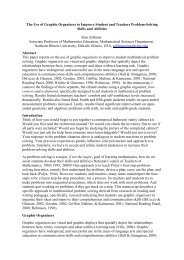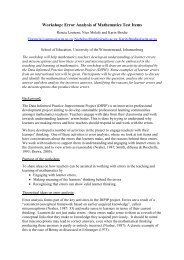Comprehensive indicators of mathematics understanding among ...
Comprehensive indicators of mathematics understanding among ...
Comprehensive indicators of mathematics understanding among ...
Create successful ePaper yourself
Turn your PDF publications into a flip-book with our unique Google optimized e-Paper software.
een conducted. These studies, however, have been generally looked at skills acquired at specificarea or level and thus are limited in scope.This proposed study aims a more comprehensive look and simultaneously probe into students’attainment both in terms <strong>of</strong> skills and levels <strong>of</strong> <strong>understanding</strong>. The inquiry into and creating theSchool Science and Mathematics Indicators Program (SSMIP) will produce comprehensive andcomputerized guidelines on school-leavers achievement <strong>indicators</strong> in both science and<strong>mathematics</strong>. Potential users will include all higher institutions <strong>of</strong> learning both public andprivate institutions, and individual science and <strong>mathematics</strong> educators. While this type <strong>of</strong> schoolachievement <strong>indicators</strong> are quite common in developed countries, they are, however, new in theMalaysian scenario.The basic principles <strong>of</strong> assessmentThe word assessment refers to the process <strong>of</strong> collecting and using evidence about students’learning. Assessment and evaluation both describe the processes <strong>of</strong> collecting and interpretingevidence for some purpose. They both involve decisions about what evidence to use, thecollection <strong>of</strong> that evidence in a systematic and planned way and the interpretation <strong>of</strong> the evidenceis to produce to produce some <strong>of</strong> judgment (Harlen, 2007, Harlen2008, Khodori, 200; Salvia, J.&Ysseldke. J. E. 2001).This description is illustrated by the following diagram:In a nutshell “Educational assessment is formal attempt to determine students’ status with respectto educational variables <strong>of</strong> interest (Popham, 2006; pg 6)In recent years educators have been urged to broaden their conception <strong>of</strong> testing so students’status determined via a wider variety <strong>of</strong> measuring devices – a variety extending well beyond thetraditional paper-and-pencil tests. Thus they are many worthwhile learning outcomes not bestmeasured by paper-and-pencil tests. Assessment is a broader descriptor <strong>of</strong> the kinds <strong>of</strong>educational measuring teachers do – a descriptor that, while certainly including traditional pap erand pencil tests, covers many more kinds <strong>of</strong> measuring procedures.Noor Azlan Ahmad Zanzali (2005) emphasized assessment must be based and address severalcritical issues <strong>of</strong> teaching and learning. They areIssue 1: Underlying assumptions about the philosophy and goals <strong>of</strong> the curriculumIssue 2: Assessment must be in consonance with current learning and instructionalconsiderationsIssue 3: Specifications <strong>of</strong> performance standardsIssue 4: Developing authentic tasksIssue 5: Assessment should measure status and growthIssue 6: Scoring and what form?Issue 7: Reporting –making publicObjectives <strong>of</strong> the ResearchThis research program aims to identify the levels <strong>of</strong> <strong>mathematics</strong> <strong>understanding</strong> <strong>among</strong>st secondary school students,corresponding to their levels <strong>of</strong> schooling students’ abilities to acquire a variety <strong>of</strong>mathematical concepts,







